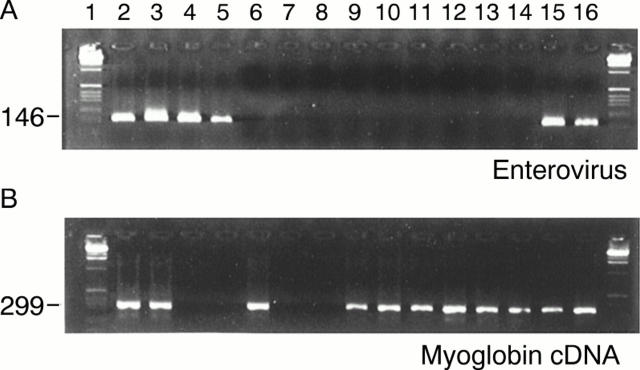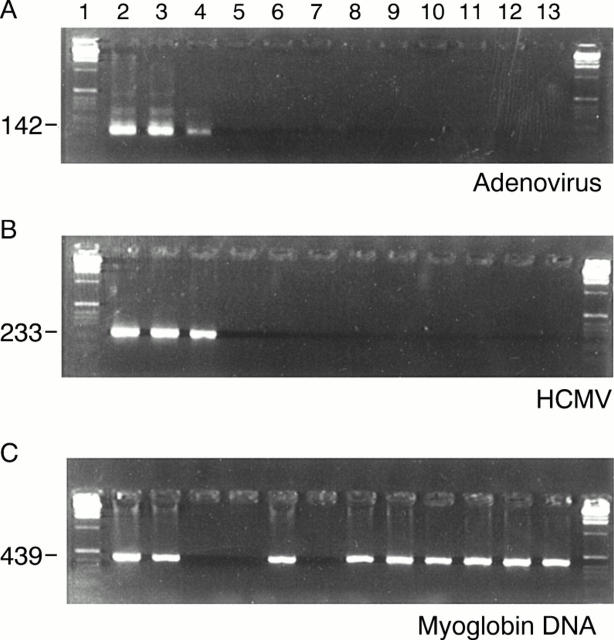Abstract
OBJECTIVE—To investigate whether viral infection acts as a trigger factor for the development of dilated cardiomyopathy in genetically predisposed individuals with a family history of disease. SETTING—Patients attending the cardiomyopathy unit in a cardiac tertiary referral centre. DESIGN—Nested polymerase chain reaction (nPCR) was used to determine whether enteroviral, adenoviral, or cytomegaloviral nucleic acids were detectable in the myocardium of 19 asymptomatic relatives of patients with dilated cardiomyopathy; all these relatives had echocardiographic abnormalities thought to represent early disease. Explanted hearts from patients with end stage dilated cardiomyopathy were also studied and were compared with 25 controls (ischaemic heart disease (21), valvar heart disease (2), hypertrophic cardiomyopathy (1), restrictive cardiomyopathy (1)). Myocardial tissue from two fatal cases of culture positive coxsackie myocarditis was used as a positive control. RESULTS—No viral nucleic acid was detected in any group other than in those with myocarditis. Spiking of random wells with purified recombinant viral nucleic acids confirmed the sensitivity and reproducibility of the assays. CONCLUSIONS—Myocardial viral infection is not detectable in relatives of patients with dilated cardiomyopathy who are suspected of having early disease. There is no evidence that viruses act as a trigger factor for initiating the dilated cardiomyopathy in these patients. Keywords: viral infection; dilated cardiomyopathy
Full Text
The Full Text of this article is available as a PDF (135.5 KB).
Figure 1 .
(A) Nested enteroviral reverse transcription polymerase chain reaction (PCR), performed on left ventricular and septal tissue obtained from explanted hearts and biopsies taken from patients with familial early dilated cardiomyopathy. Representative data are shown in lanes 9 to 14. Other lanes are: culture grown coxsackie virus B3 (CVB3; lane 2), CVB3 infected mouse heart (lane 3), 5 and 0.5 copies of pBlue script plasmid carrying CVB3 cDNA (lanes 4 and 5, respectively), and CVB3 infected human hearts (lanes 15 and 16); molecular weight markers are shown in the first and last lanes; reagent contamination controls from first and second rounds of PCR amplification are shown in lanes 7 and 8, respectively; an uninfected mouse heart used as negative control is shown in lane 6. (B) Amplification of the myoglobin housekeeping gene following reverse transcription. The order of samples as for panel (A).
Figure 2 .
(A) Nested polymerase chain reaction (PCR) amplification of adenovirus, performed on left ventricular and septal tissue obtained from explanted hearts and biopsies taken from patients with familial early dilated cardiomyopathy. Representative data are shown in lanes 8-13. Other lanes are: molecular weight markers in the first and last lanes; culture grown adenovirus (lane 2), 10 and 5 copies of plasmid pJM17 carrying adenovirus sequences used for sensitivity assessments (lanes 3 and 4, respectively), uninfected mouse heart (lane 5), reagent contamination controls for first and second round of PCR amplification (lanes 6 and 7, respectively). (B) Nested PCR amplification of human cytomegalovirus (HCMV). The order of presentation of samples is as for panel (A). Culture grown HCMV is shown in lane 2. The sensitivity controls used were 100 and 10 copies of the plasmid pMV100 carrying HCMV sequences (lanes 3 and 4, respectively). (C) Amplification of the myoglobin gene from DNA. Cardiac samples are shown in wells 8 to 13. Adenovirus and HCMV cell cultures are shown in wells 2 and 3, respectively. Uninfected murine heart is shown in well 6 and the reagent negative control in well 7. No samples were loaded in wells 4 and 5.
Selected References
These references are in PubMed. This may not be the complete list of references from this article.
- Akaboshi E. Cloning of the human myoglobin gene. Gene. 1985;33(3):241–249. doi: 10.1016/0378-1119(85)90231-8. [DOI] [PubMed] [Google Scholar]
- Allard A., Albinsson B., Wadell G. Detection of adenoviruses in stools from healthy persons and patients with diarrhea by two-step polymerase chain reaction. J Med Virol. 1992 Jun;37(2):149–157. doi: 10.1002/jmv.1890370214. [DOI] [PubMed] [Google Scholar]
- Archard L. C., Khan M. A., Soteriou B. A., Zhang H., Why H. J., Robinson N. M., Richardson P. J. Characterization of Coxsackie B virus RNA in myocardium from patients with dilated cardiomyopathy by nucleotide sequencing of reverse transcription-nested polymerase chain reaction products. Hum Pathol. 1998 Jun;29(6):578–584. doi: 10.1016/s0046-8177(98)80006-3. [DOI] [PubMed] [Google Scholar]
- Arola A., Kallajoki M., Ruuskanen O., Hyypia T. Detection of enteroviral RNA in end-stage dilated cardiomyopathy in children and adolescents. J Med Virol. 1998 Dec;56(4):364–371. doi: 10.1002/(sici)1096-9071(199812)56:4<364::aid-jmv13>3.0.co;2-8. [DOI] [PubMed] [Google Scholar]
- Baboonian C., Treasure T. Meta-analysis of the association of enteroviruses with human heart disease. Heart. 1997 Dec;78(6):539–543. doi: 10.1136/hrt.78.6.539. [DOI] [PMC free article] [PubMed] [Google Scholar]
- Badorff C., Lee G. H., Lamphear B. J., Martone M. E., Campbell K. P., Rhoads R. E., Knowlton K. U. Enteroviral protease 2A cleaves dystrophin: evidence of cytoskeletal disruption in an acquired cardiomyopathy. Nat Med. 1999 Mar;5(3):320–326. doi: 10.1038/6543. [DOI] [PubMed] [Google Scholar]
- Baig M. K., Goldman J. H., Caforio A. L., Coonar A. S., Keeling P. J., McKenna W. J. Familial dilated cardiomyopathy: cardiac abnormalities are common in asymptomatic relatives and may represent early disease. J Am Coll Cardiol. 1998 Jan;31(1):195–201. doi: 10.1016/s0735-1097(97)00433-6. [DOI] [PubMed] [Google Scholar]
- Bowles N. E., Richardson P. J., Olsen E. G., Archard L. C. Detection of Coxsackie-B-virus-specific RNA sequences in myocardial biopsy samples from patients with myocarditis and dilated cardiomyopathy. Lancet. 1986 May 17;1(8490):1120–1123. doi: 10.1016/s0140-6736(86)91837-4. [DOI] [PubMed] [Google Scholar]
- Bowles N. E., Rose M. L., Taylor P., Banner N. R., Morgan-Capner P., Cunningham L., Archard L. C., Yacoub M. H. End-stage dilated cardiomyopathy. Persistence of enterovirus RNA in myocardium at cardiac transplantation and lack of immune response. Circulation. 1989 Nov;80(5):1128–1136. doi: 10.1161/01.cir.80.5.1128. [DOI] [PubMed] [Google Scholar]
- Caforio A. L., Keeling P. J., Zachara E., Mestroni L., Camerini F., Mann J. M., Bottazzo G. F., McKenna W. J. Evidence from family studies for autoimmunity in dilated cardiomyopathy. Lancet. 1994 Sep 17;344(8925):773–777. doi: 10.1016/s0140-6736(94)92339-6. [DOI] [PubMed] [Google Scholar]
- Cameron-Wilson C. L., Pandolfino Y. A., Zhang H. Y., Pozzeto B., Archard L. C. Nucleotide sequence of an attenuated mutant of coxsackievirus B3 compared with the cardiovirulent wildtype: assessment of candidate mutations by analysis of a revertant to cardiovirulence. Clin Diagn Virol. 1998 Apr;9(2-3):99–105. doi: 10.1016/s0928-0197(98)00008-7. [DOI] [PubMed] [Google Scholar]
- Codd M. B., Sugrue D. D., Gersh B. J., Melton L. J., 3rd Epidemiology of idiopathic dilated and hypertrophic cardiomyopathy. A population-based study in Olmsted County, Minnesota, 1975-1984. Circulation. 1989 Sep;80(3):564–572. doi: 10.1161/01.cir.80.3.564. [DOI] [PubMed] [Google Scholar]
- Giacca M., Severini G. M., Mestroni L., Salvi A., Lardieri G., Falaschi A., Camerini F. Low frequency of detection by nested polymerase chain reaction of enterovirus ribonucleic acid in endomyocardial tissue of patients with idiopathic dilated cardiomyopathy. J Am Coll Cardiol. 1994 Oct;24(4):1033–1040. doi: 10.1016/0735-1097(94)90866-4. [DOI] [PubMed] [Google Scholar]
- Grasso M., Arbustini E., Silini E., Diegoli M., Percivalle E., Ratti G., Bramerio M., Gavazzi A., Vigano M., Milanesi G. Search for Coxsackievirus B3 RNA in idiopathic dilated cardiomyopathy using gene amplification by polymerase chain reaction. Am J Cardiol. 1992 Mar 1;69(6):658–664. doi: 10.1016/0002-9149(92)90160-z. [DOI] [PubMed] [Google Scholar]
- Grumbach I. M., Heim A., Pring-Akerblom P., Vonhof S., Hein W. J., Müller G., Figulla H. R. Adenoviruses and enteroviruses as pathogens in myocarditis and dilated cardiomyopathy. Acta Cardiol. 1999 Apr;54(2):83–88. [PubMed] [Google Scholar]
- Henry W. L., Gardin J. M., Ware J. H. Echocardiographic measurements in normal subjects from infancy to old age. Circulation. 1980 Nov;62(5):1054–1061. doi: 10.1161/01.cir.62.5.1054. [DOI] [PubMed] [Google Scholar]
- Keeling P. J., Jeffery S., Caforio A. L., Taylor R., Bottazzo G. F., Davies M. J., McKenna W. J. Similar prevalence of enteroviral genome within the myocardium from patients with idiopathic dilated cardiomyopathy and controls by the polymerase chain reaction. Br Heart J. 1992 Dec;68(6):554–559. doi: 10.1136/hrt.68.12.554. [DOI] [PMC free article] [PubMed] [Google Scholar]
- Klingel K., Rieger P., Mall G., Selinka H. C., Huber M., Kandolf R. Visualization of enteroviral replication in myocardial tissue by ultrastructural in situ hybridization: identification of target cells and cytopathic effects. Lab Invest. 1998 Oct;78(10):1227–1237. [PubMed] [Google Scholar]
- Kyu B., Matsumori A., Sato Y., Okada I., Chapman N. M., Tracy S. Cardiac persistence of cardioviral RNA detected by polymerase chain reaction in a murine model of dilated cardiomyopathy. Circulation. 1992 Aug;86(2):522–530. doi: 10.1161/01.cir.86.2.522. [DOI] [PubMed] [Google Scholar]
- Liljeqvist J. A., Bergström T., Holmström S., Samuelson A., Yousef G. E., Waagstein F., Jeansson S. Failure to demonstrate enterovirus aetiology in Swedish patients with dilated cardiomyopathy. J Med Virol. 1993 Jan;39(1):6–10. doi: 10.1002/jmv.1890390103. [DOI] [PubMed] [Google Scholar]
- Limas C. J., Limas C. HLA antigens in idiopathic dilated cardiomyopathy. Br Heart J. 1989 Nov;62(5):379–383. doi: 10.1136/hrt.62.5.379. [DOI] [PMC free article] [PubMed] [Google Scholar]
- Muir P., Nicholson F., Illavia S. J., McNeil T. S., Ajetunmobi J. F., Dunn H., Starkey W. G., Reetoo K. N., Cary N. R., Parameshwar J. Serological and molecular evidence of enterovirus infection in patients with end-stage dilated cardiomyopathy. Heart. 1996 Sep;76(3):243–249. doi: 10.1136/hrt.76.3.243. [DOI] [PMC free article] [PubMed] [Google Scholar]
- Opavsky M. A., Penninger J., Aitken K., Wen W. H., Dawood F., Mak T., Liu P. Susceptibility to myocarditis is dependent on the response of alphabeta T lymphocytes to coxsackieviral infection. Circ Res. 1999 Sep 17;85(6):551–558. doi: 10.1161/01.res.85.6.551. [DOI] [PubMed] [Google Scholar]
- Pauschinger M., Bowles N. E., Fuentes-Garcia F. J., Pham V., Kühl U., Schwimmbeck P. L., Schultheiss H. P., Towbin J. A. Detection of adenoviral genome in the myocardium of adult patients with idiopathic left ventricular dysfunction. Circulation. 1999 Mar 16;99(10):1348–1354. doi: 10.1161/01.cir.99.10.1348. [DOI] [PubMed] [Google Scholar]
- Pauschinger M., Kühl U., Dörner A., Schieferecke K., Petschauer S., Rauch U., Schwimmbeck P. L., Kandolf R., Schultheiss H. P. Nachweis enteroviraler RNA in endomyokardialen Biopsien bei inflammatorischer Kardiomyopathie und idiopathischer dilatativer Kardiomyopathie. Z Kardiol. 1998 Jun;87(6):443–452. doi: 10.1007/s003920050199. [DOI] [PubMed] [Google Scholar]
- Petitjean J., Kopecka H., Freymuth F., Langlard J. M., Scanu P., Galateau F., Bouhour J. B., Ferrière M., Charbonneau P., Komajda M. Detection of enteroviruses in endomyocardial biopsy by molecular approach. J Med Virol. 1992 May;37(1):76–82. doi: 10.1002/jmv.1890370114. [DOI] [PubMed] [Google Scholar]
- Richardson P., McKenna W., Bristow M., Maisch B., Mautner B., O'Connell J., Olsen E., Thiene G., Goodwin J., Gyarfas I. Report of the 1995 World Health Organization/International Society and Federation of Cardiology Task Force on the Definition and Classification of cardiomyopathies. Circulation. 1996 Mar 1;93(5):841–842. doi: 10.1161/01.cir.93.5.841. [DOI] [PubMed] [Google Scholar]
- Sugrue D. D., Rodeheffer R. J., Codd M. B., Ballard D. J., Fuster V., Gersh B. J. The clinical course of idiopathic dilated cardiomyopathy. A population-based study. Ann Intern Med. 1992 Jul 15;117(2):117–123. doi: 10.7326/0003-4819-117-2-117. [DOI] [PubMed] [Google Scholar]
- Weiss L. M., Movahed L. A., Billingham M. E., Cleary M. L. Detection of Coxsackievirus B3 RNA in myocardial tissues by the polymerase chain reaction. Am J Pathol. 1991 Feb;138(2):497–503. [PMC free article] [PubMed] [Google Scholar]
- Why H. J., Meany B. T., Richardson P. J., Olsen E. G., Bowles N. E., Cunningham L., Freeke C. A., Archard L. C. Clinical and prognostic significance of detection of enteroviral RNA in the myocardium of patients with myocarditis or dilated cardiomyopathy. Circulation. 1994 Jun;89(6):2582–2589. doi: 10.1161/01.cir.89.6.2582. [DOI] [PubMed] [Google Scholar]
- Wolfgram L. J., Beisel K. W., Herskowitz A., Rose N. R. Variations in the susceptibility to Coxsackievirus B3-induced myocarditis among different strains of mice. J Immunol. 1986 Mar 1;136(5):1846–1852. [PubMed] [Google Scholar]
- Zal B., Pinto-Basto J., Milne R., Li M. S., Jeeachee M., Baboonian C. Immunological analysis of the tegument phosphoprotein ppUL83 of human cytomegalovirus. J Virol Methods. 2000 Mar;85(1-2):183–192. doi: 10.1016/s0166-0934(99)00168-8. [DOI] [PubMed] [Google Scholar]
- de Leeuw N., Melchers W. J., Balk A. H., de Jonge N., Galama J. M. No evidence for persistent enterovirus infection in patients with end-stage idiopathic dilated cardiomyopathy. J Infect Dis. 1998 Jul;178(1):256–259. doi: 10.1086/517448. [DOI] [PubMed] [Google Scholar]
- de Leeuw N., Melchers W. J., Balk A. H., de Jonge N., Galama J. M. Study on microbial persistence in end-stage idiopathic dilated cardiomyopathy. Clin Infect Dis. 1999 Sep;29(3):522–525. doi: 10.1086/598625. [DOI] [PubMed] [Google Scholar]




